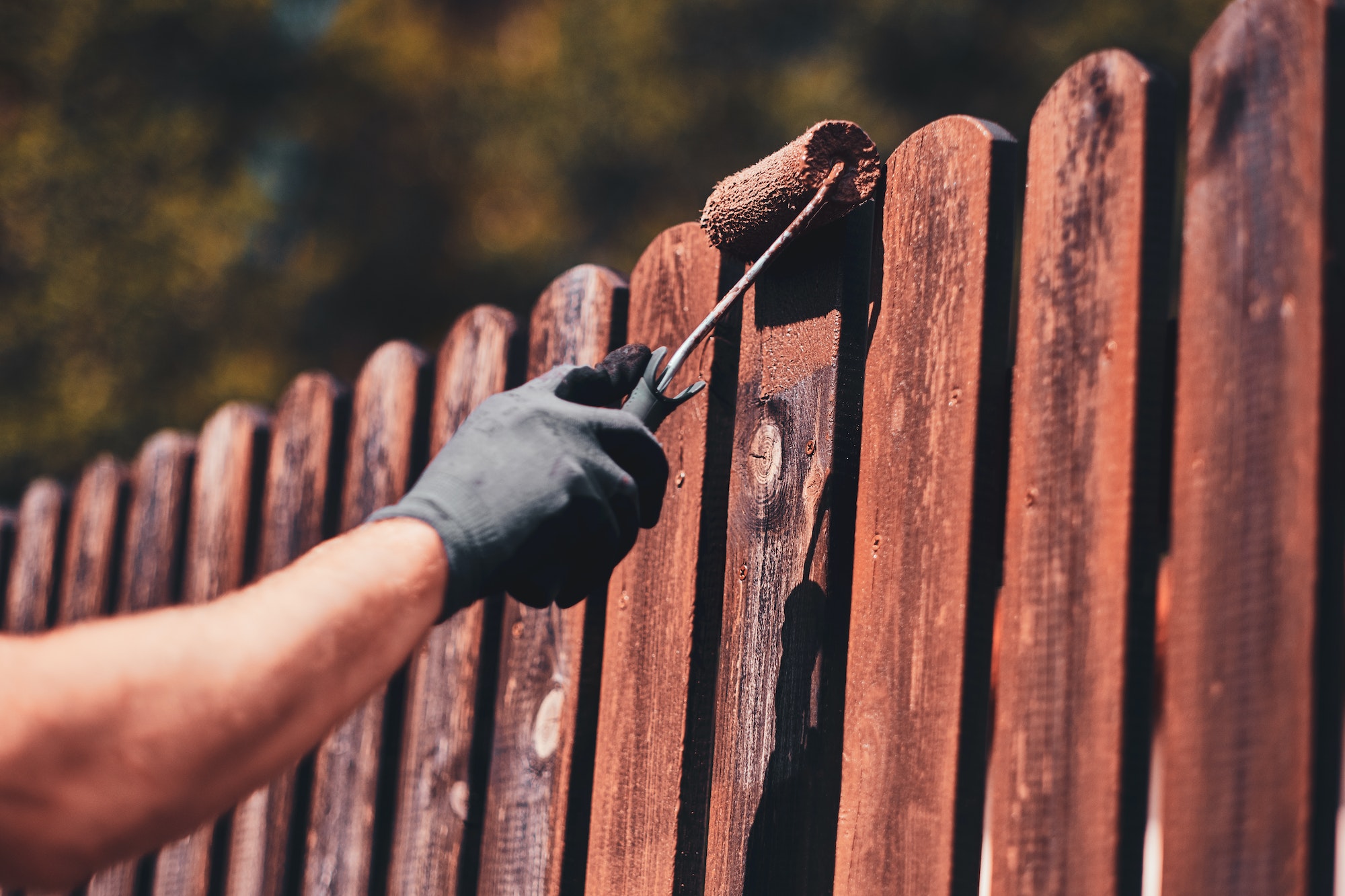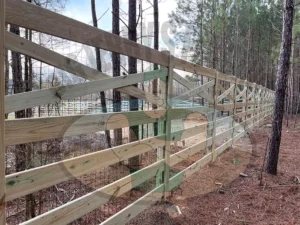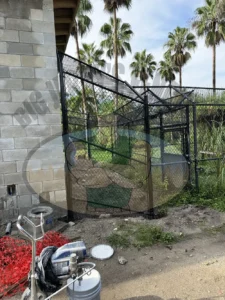A wood fence is a great way to add protection, privacy, and value to your home while keeping the beautiful natural look that a custom-built wood fence provides. However, wood is a natural material that will age and wither over time. If you have ever had a wooden fence installed, you will notice that the appearance of the lumber will start to turn grey. Staining or painting a fence is one of the most common ways homeowners can spruce up their old fence and breathe new life into it. Staining your new fence gives you design versatility with different color options and can help protect the aesthetic appeal of your fence for years to come.
Fun fact: homeowners in the United States alone account for 1.4 Billion gallons of paint every year, while fence staining, though a much more niche industry, is still valued as a Billion-dollar market by expert estimates. Anyway, we have compiled answers to some of the most frequently asked questions (FAQs) related to fence stain and paint, starting with:
THE STAIN VS. PAINT DEBATE
Is it better to stain or paint a new fence?
Most of the time, staining is better than painting a fence. It’s true that the stain eventually fades and must be reapplied, but not for several years. Also, because the stain doesn’t peel or crack, it requires less preparation than repainting. Simply power wash the fence to produce a clean, prepped surface for staining. So, in short, generally, you’re better off staining rather than painting a fence.
Is it cheaper to stain or paint a fence?
Paint is less expensive, but you’ll need more of it, as well as a primer. Stain is more expensive, but you won’t need as much of it; plus, it can last longer than paint. In the end, both products cost about the same when you consider how much you need and how long they last. It boils down to whether you can afford the upfront cost to stain your fence; if yes, then by all means, go for it, and if not, then you’re better off painting your fence.
How long does a stained or painted fence last?
Stain can last anywhere from 1 to 8 years, depending on how opaque the stain is. Transparent stain lasts a short time, while an opaque stain lasts longer. Paint lasts up to 10 years if it is properly applied and the right type of paint is used. It’s important to apply high-quality exterior-grade paint. The rule of thumb here is that the more expensive and high-grade paint or stain you apply on your fence, the greater the likelihood of said stain or coat of paint lasting longer.
THE SKINNY ON STAINING YOUR FENCE:
How long should you wait before staining a new fence?
A good waiting window is about a month or two if the fence is made with dry materials. This will allow it to wither just enough but not too much. If the fence is made with pressure-treated materials, it may take 3-4 months for the posts to dry enough. It’s better you check with a moisture meter for a more accurate assessment.
When is the best time to stain my fence?
Early or late summer are ideal times to stain a fence. You’ll need a few days of dry, warm weather, both before and after you stain. The boards need to be completely dry. A cloudy day, early in the morning or late in the afternoon are good times to work, too.
What is the best temperature to stain a fence?
For most stains, 70 degrees Fahrenheit is the optimum temperature, with a safety range of 20 degrees on either side. So, a margin between 50 to 90 degrees Fahrenheit is there. Stains do vary, so check the label first. However, you gotta absolutely avoid high humidity and staining on hot surfaces. All finishes, including stains and paint, have trouble drying in moist conditions.
How many coats of stain do I need for a fence?
Solid-color stains are identical to regular paint in most situations, and only one coat is needed to protect your fence. Two coats are also required for semi-transparent penetrating stains. Do keep in mind, though, that the second coat to be applied should approximately be done after an hour from the first coat.
How do you prepare a fence for staining?
First, you clean the fence surface by applying a cleaner — a small solution of soapy bleach water may be all you need, but seek out a fence/deck cleaner for those pesky, tougher stains. Next, scrub with a stiff bristle brush to remove dirt, debris, and mildew. Finally, you rinse thoroughly with a high pressure nozzle attached to a hose or a pressure washer. Voila, you’re all set for fence staining, now.
Do you need to power wash the fence before staining?
Let’s get this outta the way, first: You don’t need to power wash your fence before staining, but it is highly recommended. Basically, pressure washing the fence clean before staining often guarantees that blemishes are avoided that may be seen through the surface of the stain. In addition, the pressure wash before staining eliminates any debris collected between the wood that prevents mold and fungus from developing. So, in short: not necessary, but will definitely help you long term if you do.
Should you stain both sides of a fence?
Short answer, yes. Because, in actuality, you should be staining both sides of your fence. It’ll be more aesthetically pleasing not just for you but for your neighbors, too. Also, it will help your wooden fence last longer. You gotta factor in the fact that as the days continue to get longer and the sun beats down a little harder, your fence will be put through its paces, so sun protection should be on your mind.
PREPARING TO PAINT YOUR FENCE:
How long should you wait before painting a new fence?
Wait a month or two if the fence is made with dry materials. Just like with fencing, this waiting period for drying will allow the fence to wither enough to be ready for painting. Again, similar to fence staining, If the fence is made with pressure-treated materials, the wait may extend to 3-4 months for the posts to dry enough. You can use a moisture meter to determine if your fence’s ready an dry for you to paint over.
How often should I repaint my fence?
To avoid the fence’s surface showing signs of peeling and cracking, it’s advised to repaint your fence every 1-3 years or as soon as any imperfections begin to appear. Paint also restricts the ability of the timber to breath. This can increase moisture content, which results in potential problems with rotting. So, yeah carefully examine your fences every few months just in case, but generally within a year is the ideal time.
Does painting a fence make it last longer?
A quality coating of paint will give your fence a solid layer of protection from the wind, sun, and rain for many years, preventing premature rot. You gotta understand that wood on its own does not last long in the elements. Paint can ensure that the wood is sealed and will extend the life of your fencing and protect your investment. For more info contact Big Jerry’s Fence Company.



















